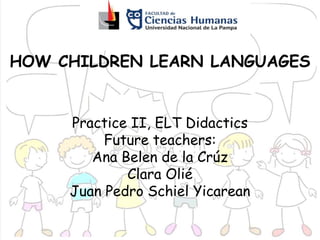
How children learn languages
- 1. HOW CHILDREN LEARN LANGUAGES Practice II, ELT Didactics Future teachers: Ana Belen de la Crúz Clara Olié Juan Pedro Schiel Yicarean
- 2. STAGES OF L1 ACQUISITION 1-BABBLING (0 -8 MONTHS) -they produce noises and sounds 2-THE FIRST WORD (11 MONTHS-1 YEAR OLD) - they start communicating -word-oject associations 3-TWO WORDS (2 YEARS OLD) -syntax -meaning
- 3. 4- PHONOLOGICAL, SEMANTIC, AND LEXICAL NORMS (3-4 YEARS OLD) -vowels and consonants -adult-like language organization 5- SYNTACTIC AND LEXICAL COMPLEXITY AND RICHNESS (BETWEEN 6 AND 12) -expansion of vocabulary and language understanding -linguistic stimulation -abstract definitions 6- CONVERSATIONAL SKILLS -comprehensive improvement -recognition of problems and possible solutions -understanding of other people’s perspectives
- 4. LANGUAGE USE -to get attention -to get what they want -to make requests and simple statements -through intonation.
- 5. -to name and classify things -to ask questions (where, what?) -To differentiate things using contrastive adjectives (big, small- short, tall- hot, cold) - they are able to use possessives (Daddy’s car)
- 6. -to ask questions by turning statements into questions through the use of intonation (cat asleep, mummy?) -to express what they want using the structure I want -to refer to events in the past and in the present (Mummy cooking)
- 7. -to make requests -to explain things and ask for explanations using why? -to ask questions using the auxiliary verbs do, can and will
- 8. -to give and ask for information -to make direct and indirect requests -to make suggestions and offers -to express feeling and attitudes -to express cause and effect relations through conditional structures -habitualization
- 9. Different views of L1 and L2 acquisition
- 10. The Behaviourist Approach The Nativist/Innatist Approach The Cognitive-developmental Approach The social-interactionist Approach
- 11. The Behaviourist Approach -repetition in the form of drills -correctness and the avoidance of errors -imitation and practice or habit formation are key processes in language development -does not take into account is children’s creativity in language use
- 12. The Nativist/Innatist Approach -children are born with an innate language acquisition device -did not consider children’s creativity as an important part of L1 and L2 learning. -did not consider real communication, i.e. the personal and social aspects of language use.
- 13. The Cognitive-developmental Approach -certain thinking skills must mature to build a framework/foundation for further language development -the Critical Period Hypothesis: there is a specific and limited time for language acquisition -however, apart from age, many factors have an impact on how people learn (motivation and learning conditions)
- 14. The Social-interactionist Approach -focus on human social interactions and the role of adult and children relationships in learning -an innate Language Acquisition Devise cannot function without the help provided by an adult -Language Acquisition Support System: scaffolding -Zone of Proximal Development - importance of social interaction and learning from working with others and the consequential learning independence
- 15. Are the L1 and L2 acquired in the same way? How different are the two processes?
- 16. similarities Most learners go through four stages: -First, they become aware of the rules that build up the language -Second, they generalize and recognize patterns of repeated rules -Third, they overgeneralize the rules and use them wrongly (go- goed; put-putted) -Four, and finally, they are able to use the patters correctly
- 17. differences -L1 acquisition is characterized for being contextualized -L2 acquisition is decontextualized -this conditions the amount of exposure to the language, i.e. the input, and the motivation for learning
- 18. Does younger mean better?
- 19. A number of theories claim that there is an age limit to develop certain skills -Young learners are said to be capable of acquiring a native-like pronunciation -Older learners -12 years old- are said to be better at learning grammatical structures or meaning relationships
- 20. The truth is that there is no such age limitation. Several factors influence the learning process Learner/individual factors: -motivation -confidence -language aptitude -personality. Contextual factors: -teaching quality -time -the quality of materials -how well teachers are trained.
- 21. Bilingualism and multilingualism Both are really advantageous for further learning. In many countries around the world, children are exposed to several languages (home-school-society). However, bilingualism and multilingualism cannot be the main objectives for schools since there are a number of limitations such as: -Rural and urban areas -Teachers’ unwillingness to work in rural areas -The limited access the learners have to English-speaking media This last constraint might the most negative, since exposure influences how motivated learners are.
- 22. Who learns how much of what language under what conditions?
- 23. Who learns? It depends on individual learner differences like -age -aptitude -motivation -willingness to make mistakes -willingness to guess or make predictions -confidence
- 24. How of what language? It depends on institutional factors like: -goals of language learning -the curriculum and syllabus -the effects of tests The goals may be oriented towards: -communicative competence and the development of positive attitudes to language learning and cultures -or towards grammatical competence -there will be agreement between the goals and the kind of tests learners will have to go through
- 25. Under what conditions? the situation and context under which the L2 is learned. language development is divided into 3 parts -sequence of development: -simple vocabulary -basic syntax -simple sentences -complex sentences -order -speed of development Both the sequence and speed of development concern mainly the learners and how trained or developed are their multiple intelligences
- 26. Other important situational factors and conditions from the context are: -the environment -the type of classroom -the topics that are dealt with -the input learners receive